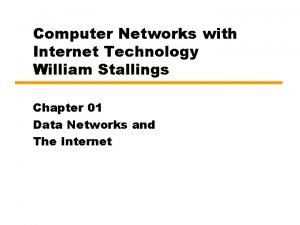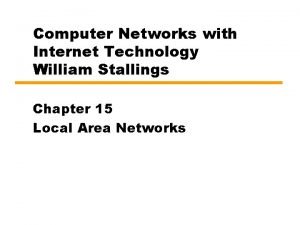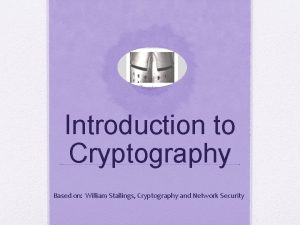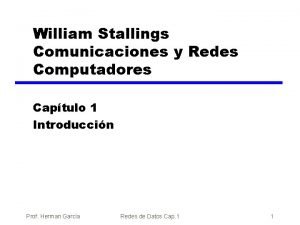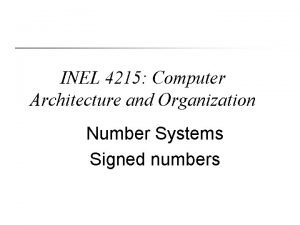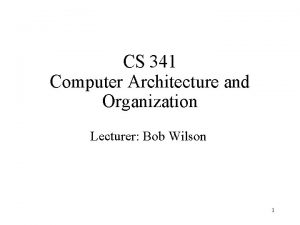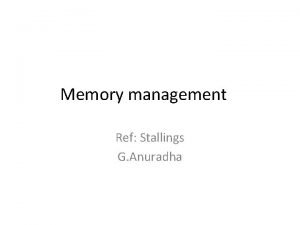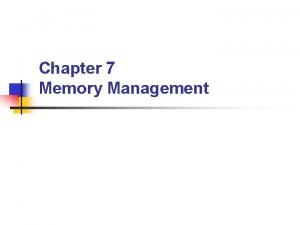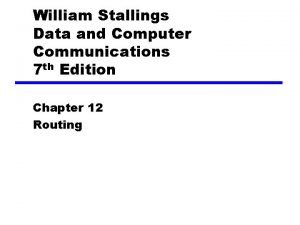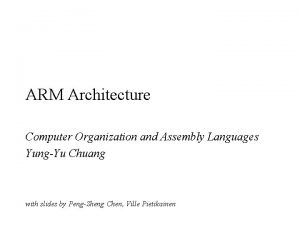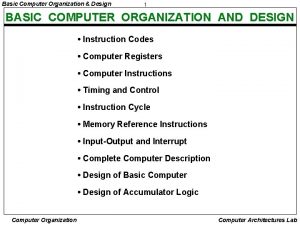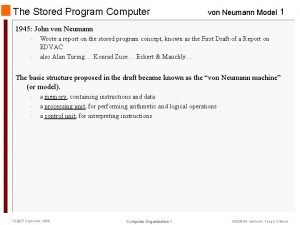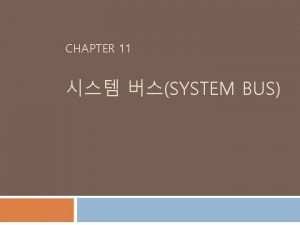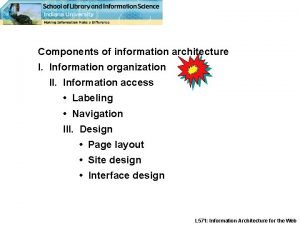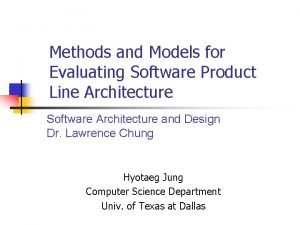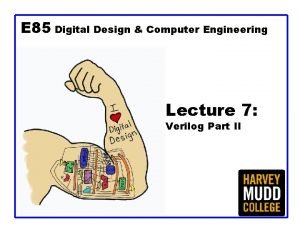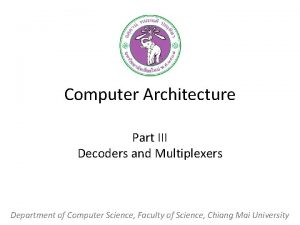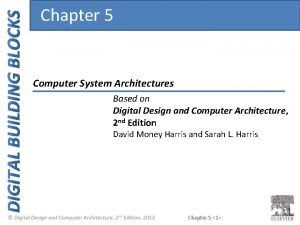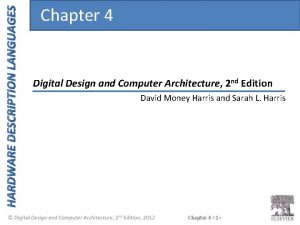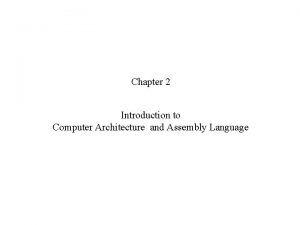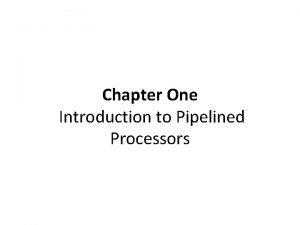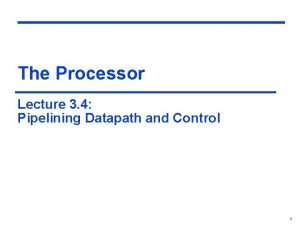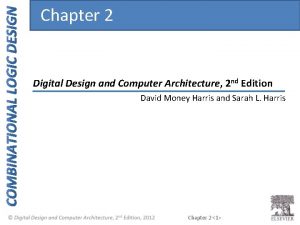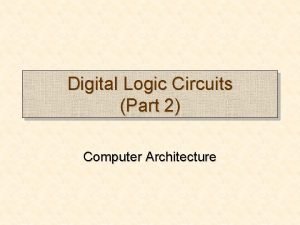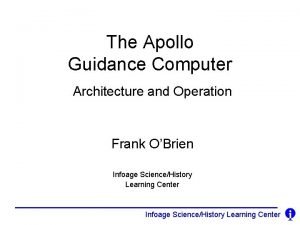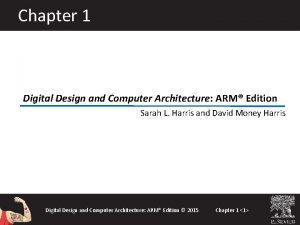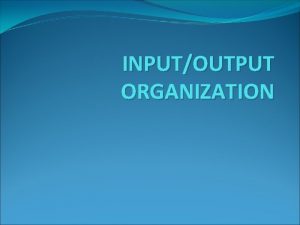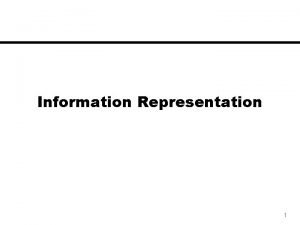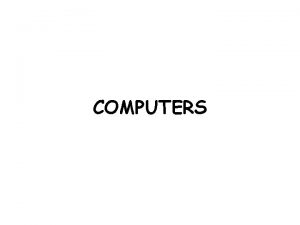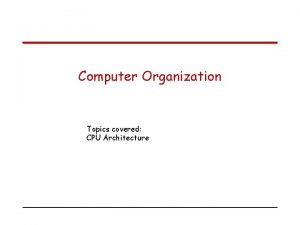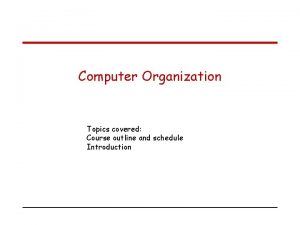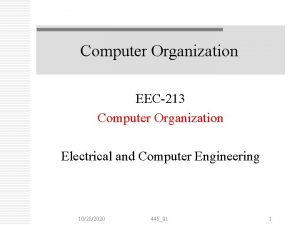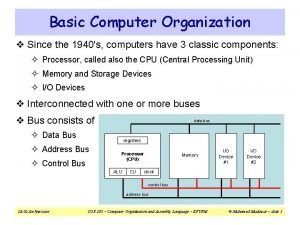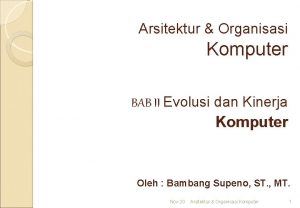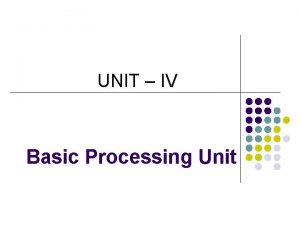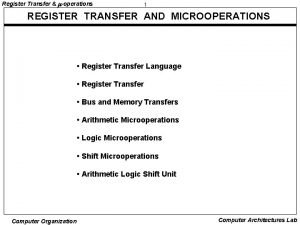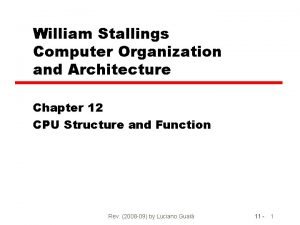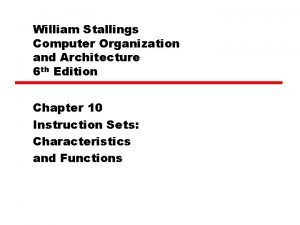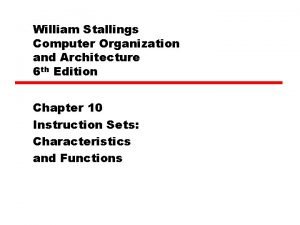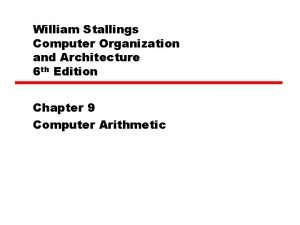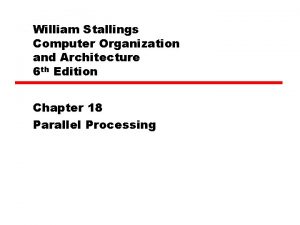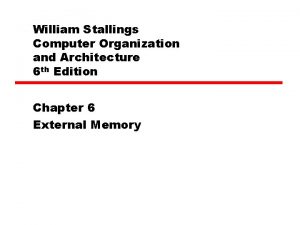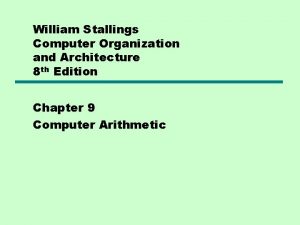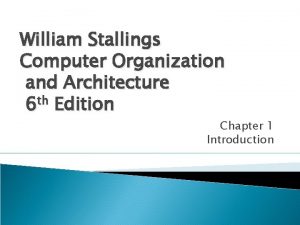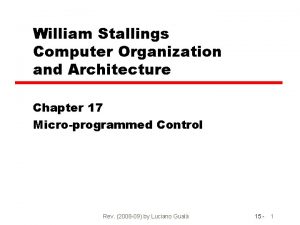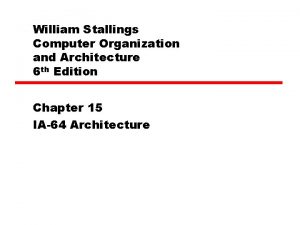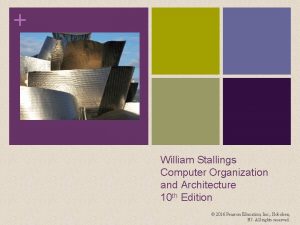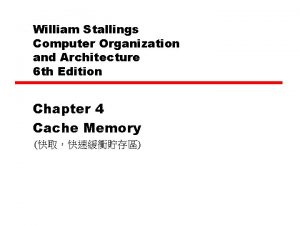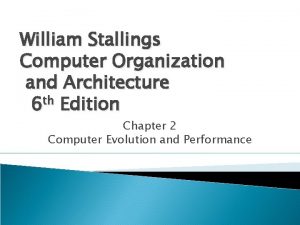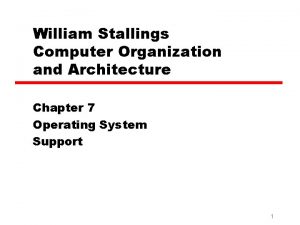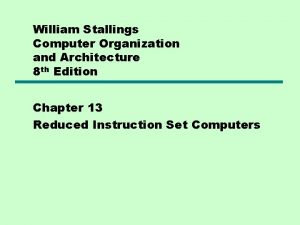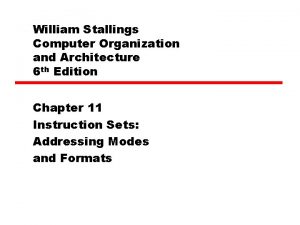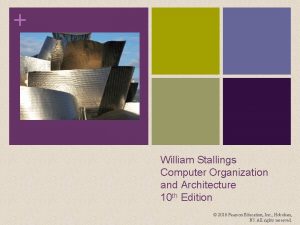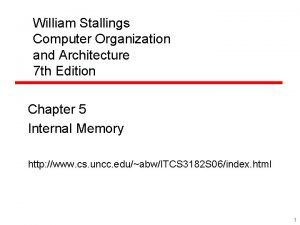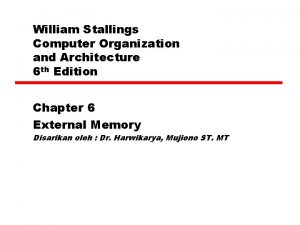William Stallings Computer Organization and Architecture 7 th


































































- Slides: 66

William Stallings Computer Organization and Architecture 7 th Edition Chapter 4 Cache Memory

Characteristics • • Location Capacity Unit of transfer Access method Performance Physical type Physical characteristics Organisation

Location • Whether the memory relative to CPU is —Internal: the main memory, registers and cache all are kind of internal memories —External: peripheral storage device such as disk and tape. They are accessible to CPU via device controller.

Capacity • Word size — For internal memory, this is expressed in bytes or words. The common word length is 8, 16, 32 or 64 bits —The word is the natural unit of organisation, and is equal to the number of bits to represent instruction (some times there is exceptions for that). • Number of words —or Bytes

Unit of Transfer • Internal —Usually governed by data bus width • External —Usually a block which is much larger than a word • Addressable unit —Smallest location which can be uniquely addressed —Word internally —Cluster on M$ disks

Access Methods (1) • Sequential —Start at the beginning and read through in order —Access time depends on location of data and previous location —e. g. tape • Direct —Individual blocks have unique address —Access is by jumping to vicinity plus sequential search —Access time depends on location and previous location —e. g. disk

Access Methods (2) • Random —Individual addresses identify locations exactly —Access time is independent of location or previous access —e. g. RAM • Associative —Data is located by a comparison with contents of a portion of the store —Access time is independent of location or previous access —e. g. cache

Memory Hierarchy • Registers —In CPU • Internal or Main memory —May include one or more levels of cache —“RAM” • External memory —Backing store

Memory Hierarchy - Diagram

Performance • Access time —Time between presenting the address and getting the valid data • Memory Cycle time —Time may be required for the memory to “recover” before next access. —This time allow transient of the line signal to die (damping), or to regenerate data if they read destructively. —Cycle time is access + recovery • Transfer Rate —Rate at which data can be moved

Physical Types • Semiconductor —RAM • Magnetic —Disk & Tape • Optical —CD & DVD • Others —Bubble —Hologram

Physical Characteristics • • Decay Volatility Erasable Power consumption

Organisation • Physical arrangement of bits into words • Not always obvious • e. g. interleaved

The Bottom Line • How much? —Capacity • How fast? —Time is money • How expensive?

Hierarchy List • • Registers L 1 Cache L 2 Cache Main memory Disk cache Disk Optical Tape

So you want fast? • It is possible to build a computer which uses only static RAM (see later) • This would be very fast • This would need no cache —How can you cache? • This would cost a very large amount

Locality of Reference • During the course of the execution of a program, memory references tend to cluster • e. g. loops

Cache • Small amount of fast memory to improve the performance with cheap price. • Sits between normal main memory and CPU to keep part of the data and instructions in the main memory. • May be located on CPU chip or module

Cache • Hit: when the processor fetch word and find it in the cache, otherwise Miss occurs. • If miss occurs the block of the required word (consists of fixed number of words) is read from main memory and saved in the cache. • Because of the locality principle, it likely to find the next referenced data or instructions in the cache as result of binging the whole block rather than the required word.

Cache • Memory of size 2 n will have n address lines. • The main memory is divided into blocks , each block consists of k words (i. e. the number of blocks M = 2 n/k. • The cache consists of lines C , each has the same size as block and C << M. • At any time the cache will holds some blocks which are involved with processor work at that time. • As the number of C is much less than the number of blocks, each line will have tag to indicate the block it holds.

Cache/Main Memory Structure

Cache operation – overview • • CPU requests contents of memory location Check cache for this data If present, get from cache (fast) If not present, read required block from main memory to cache • Then deliver from cache to CPU • Cache includes tags to identify which block of main memory is in each cache slot

Cache Read Operation - Flowchart

Cache Design • • • Size Mapping Function Replacement Algorithm Write Policy Block Size Number of Caches

Size does matter • Cost —More cache is more expensive • Speed —More cache is faster (up to a point) —Checking cache for data takes time

Typical Cache Organization

Comparison of Cache Sizes L 1 cachea L 2 cache L 3 cache Mainframe Year of Introduction 1968 16 to 32 KB — — PDP-11/70 Minicomputer 1975 1 KB — — VAX 11/780 Minicomputer 1978 16 KB — — IBM 3033 Mainframe 1978 64 KB — — IBM 3090 Mainframe 1985 128 to 256 KB — — Intel 80486 PC 1989 8 KB — — Pentium PC 1993 8 KB/8 KB 256 to 512 KB — Power. PC 601 PC 1993 32 KB — — Power. PC 620 PC 1996 32 KB/32 KB — — Power. PC G 4 PC/server 1999 32 KB/32 KB 256 KB to 1 MB 2 MB IBM S/390 G 4 Mainframe 1997 32 KB 256 KB 2 MB IBM S/390 G 6 Mainframe 1999 256 KB 8 MB — Pentium 4 2000 8 KB/8 KB 256 KB — 2000 64 KB/32 KB 8 MB — CRAY MTAb PC/server High-end server/ supercomputer Supercomputer 2000 8 KB 2 MB — Itanium PC/server 2001 16 KB/16 KB 96 KB 4 MB SGI Origin 2001 High-end server 2001 32 KB/32 KB 4 MB — Itanium 2 PC/server 2002 32 KB 256 KB 6 MB IBM POWER 5 High-end server 2003 64 KB 1. 9 MB 36 MB CRAY XD-1 Supercomputer 2004 64 KB/64 KB 1 MB — Processor Type IBM 360/85 IBM SP

Mapping Function • Cache of 64 k. Byte • Cache block of 4 bytes —i. e. cache is 16 k (214) lines of 4 bytes • 16 MBytes main memory • 24 bit address —(224=16 M)

Direct Mapping • Each block of main memory maps to only one cache line —i. e. if a block is in cache, it must be in one specific place • Address is in two parts • Least Significant w bits identify unique word (w depends on the block size) • Most Significant s bits specify one memory block • The MSBs are split into a cache line field r and a tag of s-r (most significant)

Direct Mapping Address Structure Tag s-r 8 Line or Slot r Word w 14 • 24 bit address • 2 bit word identifier (4 byte block) • 22 bit block identifier — 8 bit tag (=22 -14) [N. B. the no. of lines in the cache are 2 14= 16 K lines] — 14 bit slot or line • No two blocks in the same line have the same Tag field • Check contents of cache by finding line and checking Tag 2

Direct Mapping Cache Line Table • Cache line • 0 • 1 Main Memory blocks held 0, m, 2 m, 3 m… 2 s-m 1, m+1, 2 m+1… 2 s-m+1 • m-1, 2 m-1, 3 m-1… 2 s-1

Direct Mapping Cache Organization

Direct Mapping Example

Direct Mapping Summary • Address length = (s + w) bits • Number of addressable units = 2 s+w words or bytes • Block size = line size = 2 w words or bytes • Number of blocks in main memory=2 s+w/2 w = 2 s • Number of lines in cache = m = 2 r • Size of tag = (s – r) bits

Direct Mapping pros & cons • Simple • Inexpensive • Fixed location for given block —If a program accesses 2 blocks that map to the same line repeatedly, cache misses are very high

Associative Mapping • A main memory block can load into any line of cache • Memory address is interpreted as tag and word • Tag uniquely identifies block of memory • Every line’s tag is examined for a match • Cache searching gets expensive

Fully Associative Cache Organization

Associative Mapping Example

Associative Mapping Address Structure Word 2 bit Tag 22 bit • 22 bit tag stored with each 32 bit block of data • Compare tag field with tag entry in cache to check for hit • Least significant 2 bits of address to identify which 8 bit byte number is required from 32 bit data block • e. g. — Address — FFFFFC Tag 3 FFFFF Data 2468 Cache line 3 FFF

Associative Mapping Summary • Address length = (s + w) bits • Number of addressable units = 2 s+w words or bytes • Block size = line size = 2 w words or bytes • Number of blocks in main memory = 2 s+w/2 w = 2 s • Number of lines in cache = undetermined • Size of tag = s bits

Set Associative Mapping • Cache is divided into a number of sets • Each set contains a number of lines • A given block maps to any line in a given set —e. g. Block B can be in any line of set i • e. g. 2 lines per set — 2 way associative mapping —A given block can be in one of 2 lines in only one set

Set Associative Mapping Example • 13 bit set number • Block number in main memory is modulo 213 • 000000, 00 A 000, 00 B 000, 00 C 000 … map to same set

Two Way Set Associative Cache Organization

Set Associative Mapping Address Structure Tag 9 bit Word 2 bit Set 13 bit • Use set field to determine cache set to look in • Compare tag field to see if we have a hit • e. g —Address number — 1 FF 7 FFC — 001 7 FFC Tag Data Set 1 FF 001 12345678 1 FFF 11223344 1 FFF

Two Way Set Associative Mapping Example

Set Associative Mapping Summary • Address length = (s + w) bits • Number of addressable units = 2 s+w words or bytes • Block size = line size = 2 w words or bytes • Number of blocks in main memory = 2 s • Number of lines in set = k • Number of sets = v = 2 d • Number of lines in cache = kv = k * 2 d • Size of tag = (s – d) bits

Set Associative Mapping Summary • If number of sets (v) = number of lines (m) [i. e. number of lines for each set k=1], the set associative technique will convert to direct mapping. • If k=m, v=1 (set associative will be fully associative) • The most common choice (v=m/2 and k=2). • Four way set associative means (k= 4 and v=v/4).

Replacement Algorithms (1) Direct mapping • No choice • Each block only maps to one line • Replace that line

Replacement Algorithms (2) Associative & Set Associative • Hardware implemented algorithm (speed) • Least Recently used (LRU): replace the line stayed in memory longest time with no reference. • e. g. in 2 way set associative —Which of the 2 block is LRU? (use bit) • First in first out (FIFO) ( —replace block that has been in cache longest and is implemented as R. R. • Least frequently used —replace block which has had fewest hits • Random (implemented using counter)

Write Policy • A cache line must not overwritten by a block unless main memory is up to date • Multiple CPUs may have individual caches • I/O may address main memory directly and it may cause inconsistency.

Write through • All writes go to main memory as well as cache • Multiple CPUs can monitor main memory traffic to keep local (to CPU) cache up to date • Lots of traffic • Slows down writes • Remember bogus write through caches!

Write back • Updates initially made in cache only • Update bit for cache slot is set when update occurs • If block is to be replaced, write to main memory only if update bit is set • Other caches get out of sync • I/O must access main memory through cache • N. B. 15% of memory references are writes

Cache Coherency Many devices (Normally CPU’s) have caches and all are sharing memory Solutions: • Bus watching with write through • Hardware transparency: in which special hardware is used to reflect any modification in cache to memory and all other caches. • Non cacheable memory: a portion in memory only is shared and this is not allowed to be cached. (i. e. all reference to this part is causing Miss). Hardware can identify the non cacheable memory (CS).

Pentium 4 Cache • 80386 – no on chip cache • 80486 – 8 k using 16 byte lines and four way set associative organization • Pentium (all versions) – two on chip L 1 caches — Data & instructions • Pentium III – L 3 cache added off chip • Pentium 4 — L 1 caches – 8 k bytes – 64 byte lines – four way set associative — L 2 cache – – Feeding both L 1 caches 256 k 128 byte lines 8 way set associative — L 3 cache on chip

Line Size As the block size increases initially the hit ratio will increase until certain point at which the hit ratio is decreasing. • Larger block reduces the number of blocks that fit into cache contents. A small number of blocks results data to be written shortly after they are fetched. • Each additional word in large block will be less likely to be used.

Number of Caches • Single cache is found initially and with increasing chip density became available some space for on-chip cache. • The system benefits from that by reducing external bus activity (speeds up the execution time). • Because the bus of the on-chip cache is shorter than the system bus as result of few devices are connected to it, the onchip bus is faster (less delay). • During this period of using on-chip cache the system bus will be avialable for other activities.

Is still the external cache desirable? • Shortly, the answer is yes and this organization is called two level cache. • Internal cache is L 1 and the external cache is L 2. • With no L 2 cache (SRAM), in case of MISS the CPU has to access the RAM or ROM directly through the system bus (slow, and performance decreasing). • Many systems are using separate bus between L 2 and the processor to reduce burden on the system bus. • The continuous shrinking of the processor components, many system place L 2 on the processor chip (impoving the performance).

Unified against Split cache • At start L 1 cache is used for both of data and instruction. • Recently become common to split cache into one for data and the one for instructions. —Reason for modified cache are: —For specific size it will have higher Hit rate (as result of balancing data and instructions automatically). —Only one cache has to implemented and design.

Unified against Split cache • Split caches, eliminate contention particularly for supper scalar processor (Power. PC and Pentium) which emphasis parallel instruction and pre-fetching of predicted future instructions. This is very important for any design depends on pipelining.

Intel Cache Evolution Problem Solution Processor on which feature first appears External memory slower than the system bus. Add external cache using faster memory technology. 386 Increased processor speed results in external bus becoming a bottleneck for cache access. Move external cache on-chip, operating at the same speed as the processor. 486 Internal cache is rather small, due to limited space on chip Add external L 2 cache using faster technology than main memory 486 Create separate data and instruction caches. Pentium Create separate back-side bus that runs at higher speed than the main (front-side) external bus. The BSB is dedicated to the L 2 cache. Pentium Pro Contention occurs when both the Instruction Prefetcher and the Execution Unit simultaneously require access to the cache. In that case, the Prefetcher is stalled while the Execution Unit’s data access takes place. Increased processor speed results in external bus becoming a bottleneck for L 2 cache access. Some applications deal with massive databases and must have rapid access to large amounts of data. The on-chip caches are too small. Move L 2 cache on to the processor chip. Pentium II Add external L 3 cache. Pentium III Move L 3 cache on-chip. Pentium 4

Pentium 4 Block Diagram

Pentium 4 Core Processor • Fetch/Decode Unit — Fetches instructions from L 2 cache — Decode into micro-ops — Store micro-ops in L 1 cache • Out of order execution logic — Schedules micro-ops — Based on data dependence and resources — May speculatively execute • Execution units — Execute micro-ops — Data from L 1 cache — Results in registers • Memory subsystem — L 2 cache and systems bus

Pentium 4 Design Reasoning • Decodes instructions into RISC like micro-ops before L 1 cache • Micro-ops fixed length — Superscalar pipelining and scheduling • Pentium instructions long & complex • Performance improved by separating decoding from scheduling & pipelining — (More later – ch 14) • Data cache is write back — Can be configured to write through • L 1 cache controlled by 2 bits in register — CD = cache disable — NW = not write through — 2 instructions to invalidate (flush) cache and write back then invalidate • L 2 and L 3 8 -way set-associative — Line size 128 bytes

Power. PC Cache Organization • 601 – single 32 kb 8 way set associative • 603 – 16 kb (2 x 8 kb) two way set associative • 604 – 32 kb • 620 – 64 kb • G 3 & G 4 — 64 kb L 1 cache – 8 way set associative — 256 k, 512 k or 1 M L 2 cache – two way set associative • G 5 — 32 k. B instruction cache — 64 k. B data cache

Power. PC G 5 Block Diagram

Internet Sources • Manufacturer sites —Intel —IBM/Motorola • Search on cache
 William stallings computer organization and architecture
William stallings computer organization and architecture Simplified data communication model
Simplified data communication model William stallings computer networks
William stallings computer networks William stallings computer networks
William stallings computer networks William stallings network security essentials 5th edition
William stallings network security essentials 5th edition Kr
Kr William stallings
William stallings Congruence relation
Congruence relation Stallings william comunicaciones y redes de computadores
Stallings william comunicaciones y redes de computadores Cryptography william stallings
Cryptography william stallings Difference between computer architecture and organisation
Difference between computer architecture and organisation Computer organization and architecture 10th solution
Computer organization and architecture 10th solution Computer architecture virtual lab
Computer architecture virtual lab Introduction to computer organization and architecture
Introduction to computer organization and architecture Spec rating formula in computer organization
Spec rating formula in computer organization Computer organization and architecture 10th edition
Computer organization and architecture 10th edition Computer organization and architecture definition
Computer organization and architecture definition Computer architecture and organization
Computer architecture and organization Computer architecture and organization
Computer architecture and organization Process organization in computer organization
Process organization in computer organization 3 bus architecture
3 bus architecture Instruction set architecture in computer organization
Instruction set architecture in computer organization Memory organization in computer architecture
Memory organization in computer architecture Basic structure of a computer system
Basic structure of a computer system Complete computer description in computer organization
Complete computer description in computer organization Basic computer organization
Basic computer organization Garbage collection stallings
Garbage collection stallings Garbage pickup stallings
Garbage pickup stallings A.e. stallings, daphne (1999) meaning
A.e. stallings, daphne (1999) meaning Metodo stallings
Metodo stallings Least cost routing algorithm
Least cost routing algorithm Point by point arrangement
Point by point arrangement Arm in computer organization
Arm in computer organization Computer organization and design ppt
Computer organization and design ppt Basic computer design
Basic computer design Memory locations and addresses in computer organization
Memory locations and addresses in computer organization System bus in computer
System bus in computer Call and return architecture
Call and return architecture Information architecture organization schemes
Information architecture organization schemes Bapo business architecture process organization
Bapo business architecture process organization Timing and control in computer architecture
Timing and control in computer architecture Evolution of computer architecture
Evolution of computer architecture Digital design and computer architecture
Digital design and computer architecture Reservation table in pipeline
Reservation table in pipeline Digital design and computer architecture
Digital design and computer architecture Decoder expansion in computer architecture
Decoder expansion in computer architecture Digital design and computer architecture
Digital design and computer architecture Digital design and computer architecture
Digital design and computer architecture Assembly language and computer architecture
Assembly language and computer architecture Hazard detection and resolution
Hazard detection and resolution Pipeline datapath
Pipeline datapath Digital design and computer architecture
Digital design and computer architecture Digital logic and computer architecture
Digital logic and computer architecture Apollo guidance computer manual
Apollo guidance computer manual Digital design and computer architecture arm edition
Digital design and computer architecture arm edition Nano programmed control unit
Nano programmed control unit Accessing io devices
Accessing io devices Computer memory representation
Computer memory representation Basic organization of computer
Basic organization of computer Single bus structure in computer organization
Single bus structure in computer organization Computer organization topics
Computer organization topics Single bus structure in computer organization
Single bus structure in computer organization Single and multiple bus structure
Single and multiple bus structure Computer since the 1940s
Computer since the 1940s Performance in computer organization
Performance in computer organization Wide branch addressing in computer organization
Wide branch addressing in computer organization Register transfer microoperations
Register transfer microoperations


